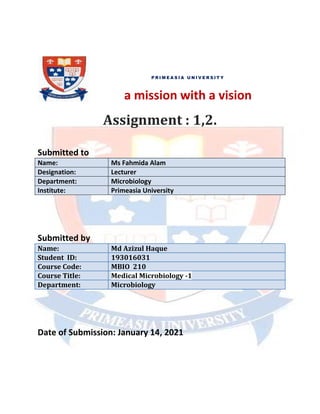
How Inter bacteria into host./ How penetrate host defenses
- 1. P R I M E A S I A U N I V E R S I T Y a mission with a vision Assignment : 1,2. Submitted to Name: Ms Fahmida Alam Designation: Lecturer Department: Microbiology Institute: Primeasia University Submitted by Name: Md Azizul Haque Student ID: 193016031 Course Code: MBIO 210 Course Title: Medical Microbiology -1 Department: Microbiology Date of Submission: January 14, 2021
- 2. Assignment : 01 How Inter bacteria into host Entry Into Host 1. Portals of Entry A. Mucous membranes (moist mucosa) -most common route for most pathogens -entry through mucus membranes: 1. respiratory tract (most common) 2. gastrointestinal tract 3. urinary/genital tracts 4. conjunctiva
- 3. B. Skin (keratinized cutaneous membrane) -some pathogens infect hair follicles and sweat glands -few can colonize surface -unless broken, skin is usually an impermeable barrier to microbes. C. Parenteral route -penetrate skin: punctures, injections, bites, cuts, surgery, etc. -deposit organisms directly into deeper tissues -most microbes must enter through their preferred portal of entry in order to cause disease -some can cause disease from many routes of entry -most usually also exit the host from the same original portal to spread disease. 2. Numbers of Invading Microbes -likelihood of disease increases as the number of invading pathogens increases ID50 (Infectious Dose) = number of microbes required to produce infection in 50% of the population
- 4. -different ID50 for different pathogens -different ID50 for different portals of entry for the same pathogen LD50 (Lethal Dose) amount of toxin or pathogen necessary to kill 50% of the population in a particular time frame Bacillus anthracis Portal of Entry ID50 Skin 10–50 endospores Inhalation 10,000–20,000 endospores Ingestion 250,000–1,000,000 endospores 3. Adherence attachment to the host by the microbe at portal of entry -usually necessary for virulence -blocking adhesion can prevent disease -pathogen has surface molecules called adhesions or ligands that bind specifically to the host surface receptors -most microbial adhesions are glycoproteins or lipoproteins located on the glycocalyx, capsule, capsid, pili, fimbriae or flagella -most host receptors are typically proteins (for virus) or carbohydrates (for bacteria) in the wall or membrane of host cell
- 5. Biofilms: -formed when microbes adhere to a surface that is usually moist and contains organic matter -each microbe secretes glycocalyx allowing other microbes to adhere; a large mass is formed -the biofilm is resistant to disinfectants and antibiotics (outer layer protects inner layers) -problem for catheters and surgical implants: serves as chronic reservoir.
- 6. Assignment : 02 How penetrate host defenses Penetration of Host Defenses 1.Capsules: organized glycocalyx layer (carbohydrates) outside cell wall impairs phagocytosis: prevents engulfment and destruction by leukocytes -if present, is usually required for virulence -some nonantigenic 2.Cell Wall Proteins: e.g. M protein of S. pyogenes -heat and acid resistant -mediates attachment of bacterium to epithelial cells -resists phagocytosis by leukocytes Fimbriae + Opa (membrane protein) used by Neisseria gohorrhoeae: -promote attachment and uptake by host epithelial cells and leukocytes -Neisseria then grows inside these cells Mycolic acid (waxy) of Mycobacterium tuberculosis
- 7. -resist digestion by phagocytes -Mycobacterium then grows inside phagocyte 3.Enzymes (exoenzymes) A. Coagulases: clot fibrin in blood to create protective barrier against host defenses B. Kinases: dissolve clots (fibrinolysis) to allow escape from isolated wounds e.g. Streptokinase (Streptococcus pyogenes) Staphylokinase (Staphylococcus aureus) C. Hyaluronidase: hydrolyzes hyaluronic acid (‘glue’ that holds together connective tissues and epithelium barriers) allowing deeper invasion e.g. Clostridium species: allows them to cause gangrene (tissue necrosis) D. Collagenase: breaks down collagen (fibrous part of connective tissue) for invasion into muscles and organs e.g. Clostridium species E. IgA proteases: destroy host IgA antibodies found in mucous secretions to allow adherence and passage at mucus membranes e.g. Neisseria species that infect CNS
- 8. 4.Antigenic Variation: Avoidance of IS, e.g. Trypanosoma Neisseria Penetration into the Host Cell Cytoskeleton: Salmonella and E. coli produce invasins, proteins that cause the actin of the host cell’s cytoskeleton to form a basket that carries the bacteria into the cell. -allows Salmonella to penetrate intestinal epithelium e.g. Shigella and Listeria -trigger endocytosis -polymerize actin behind bacterium to propel through host cell Cadherin: allows penetration between cells at intercellular junctions e.g. Shigella and Listeria: move between cells at cell junctions.
- 9. Enzymes Coagulase: Blood clot formation. Protection from phagocytosis (virulent S. aureus) Kinase: blood clot dissolve (e.g.: streptokinase) Hyaluronidase: (Spreading factor) Digestion of tissue penetration“intercellular cement” Collagenase: Collagen hydrolysis IgA protease: IgA destruction Enzymes Used for Penetration